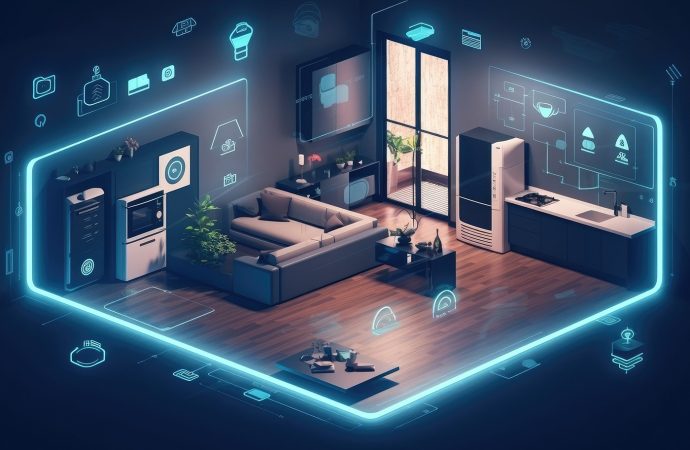The Future of Smart Home Devices: Top Trends in 2024 The landscape of smart home devices has evolved dramatically over the past decade, transforming from niche gadgets into essential components of modern living. As we approach 2024, the integration of advanced technologies promises to further revolutionize how we interact with our living spaces. This article
The Future of Smart Home Devices: Top Trends in 2024
The landscape of smart home devices has evolved dramatically over the past decade, transforming from niche gadgets into essential components of modern living. As we approach 2024, the integration of advanced technologies promises to further revolutionize how we interact with our living spaces. This article delves into the top trends shaping the future of smart home devices, providing an informative look at what to expect in the coming year.

Yandex.com
Enhanced Interoperability and Integration
One of the most significant trends in smart home devices for 2024 is enhanced interoperability and integration. As the market for smart home devices expands, consumers are increasingly demanding seamless interaction between different brands and ecosystems. Technologies like Matter, an industry-unifying standard, are set to play a crucial role in ensuring that devices from various manufacturers can communicate effectively. This will allow homeowners to integrate their smart lighting, security systems, thermostats, and entertainment devices into a cohesive, user-friendly ecosystem.
Artificial Intelligence and Machine Learning
Artificial Intelligence (AI) and Machine Learning (ML) are set to become even more integral to smart home devices in 2024. These technologies enable devices to learn from user behavior, making them more intuitive and responsive. For example, smart thermostats will be able to predict and adjust temperatures based on the homeowner’s routines and preferences, while AI-powered security cameras will enhance threat detection by distinguishing between normal activity and potential security breaches. The continued advancement of AI and ML will make smart home devices more proactive and personalized.
Energy Efficiency and Sustainability
As environmental concerns grow, energy efficiency and sustainability are becoming key considerations for consumers and manufacturers alike. Smart home devices in 2024 will focus on reducing energy consumption and promoting sustainable living. Smart thermostats, lighting systems, and appliances will be designed to optimize energy use, reducing both costs and environmental impact. Additionally, innovations such as smart solar panels and energy storage systems will enable homeowners to harness renewable energy more effectively, contributing to a greener future.
Advanced Home Security
Home security remains a top priority for smart home device development. In 2024, we can expect to see more sophisticated security systems that leverage AI, ML, and advanced sensors to provide comprehensive protection. Smart cameras will offer enhanced facial recognition capabilities, while smart locks will feature biometric authentication for added security. Integration with emergency services and real-time alerts will ensure that homeowners are promptly informed of any potential threats. Moreover, advancements in cybersecurity will address concerns about the vulnerability of smart home devices to hacking and data breaches.
Voice Control and Natural Language Processing
Voice control has already become a popular feature in smart home devices, and its prevalence is set to increase in 2024. Advances in Natural Language Processing (NLP) will make voice assistants like Amazon Alexa, Google Assistant, and Apple Siri more conversational and capable of understanding complex commands. This will allow users to control multiple devices and perform tasks with greater ease. Imagine being able to lock doors, adjust lighting, and play music simultaneously with a single voice command. Enhanced voice control will streamline the user experience and make smart home devices more accessible to a wider audience.
Health and Wellness Integration
The integration of health and wellness features into smart home devices is another emerging trend for 2024. Devices such as smart mirrors, fitness trackers, and sleep monitors will provide users with valuable insights into their health and well-being. Smart home ecosystems will be able to track daily activities, monitor vital signs, and offer personalized recommendations for a healthier lifestyle. For instance, smart lighting systems could adjust to promote better sleep patterns, while smart kitchens could suggest nutritious recipes based on dietary preferences and goals.
Immersive Entertainment Experiences
Entertainment is a key aspect of smart home devices, and 2024 will see significant advancements in this area. Smart TVs, speakers, and home theater systems will offer more immersive and interactive experiences. Technologies like augmented reality (AR) and virtual reality (VR) will be integrated into entertainment devices, allowing users to enjoy gaming, movies, and other content in entirely new ways. Additionally, multi-room audio systems will enable seamless music playback throughout the home, creating a cohesive and enjoyable entertainment environment.
Personalized and Adaptive Environments
The concept of personalized and adaptive environments is gaining traction in the realm of smart home devices. In 2024, we can expect smart homes to become even more attuned to individual preferences and needs. For example, smart lighting systems will adjust color temperatures and brightness levels based on the time of day and user activities. Smart thermostats will create personalized climate zones within the home, ensuring optimal comfort for everyone. By learning from user behavior and preferences, smart home devices will create living spaces that are tailored to individual lifestyles.
Expansion of Smart Kitchens
The kitchen is one of the most important areas of the home, and smart kitchen devices are set to become more prevalent in 2024. Innovations such as smart refrigerators, ovens, and dishwashers will offer enhanced functionality and convenience. These devices will be able to suggest recipes, monitor food inventory, and even automate cooking processes. For example, a smart oven could preheat itself and adjust cooking times based on the recipe being prepared. The expansion of smart kitchens will simplify meal preparation and make cooking more enjoyable.
5G Connectivity and IoT Expansion
The rollout of 5G connectivity is set to have a profound impact on smart home devices in 2024. With faster and more reliable internet connections, smart home devices will be able to communicate more efficiently and respond more quickly to user commands. This will enable real-time data processing and enhance the overall performance of smart home ecosystems. Additionally, the expansion of the Internet of Things (IoT) will lead to the development of new smart devices and applications, further enriching the smart home experience.
Conclusion
The future of smart home devices in 2024 s incredibly promising, with advancements in technology set to enhance convenience, security, and sustainability. Enhanced interoperability, AI and ML integration, energy efficiency, advanced security, voice control, health and wellness features, immersive entertainment, personalized environments, smart kitchens, and 5G connectivity are among the top trends to watch. As these innovations continue to evolve, smart homes will become more intuitive, responsive, and attuned to the needs of their occupants, transforming modern living in unprecedented ways.
















